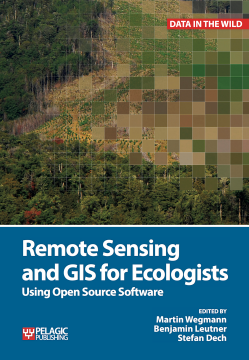
Additional Information
Book Details
Abstract
This is a book about how ecologists can integrate remote sensing and GIS in their daily work. It will allow ecologists to get started with the application of remote sensing and to understand its potential and limitations. Using practical examples, the book covers all necessary steps from planning field campaigns to deriving ecologically relevant information through remote sensing and modelling of species distributions.
All practical examples in this book rely on OpenSource software and freely available data sets. Quantum GIS (QGIS) is introduced for basic GIS data handling, and in-depth spatial analytics and statistics are conducted with the software packages R and GRASS.
Readers will learn how to apply remote sensing within ecological research projects, how to approach spatial data sampling and how to interpret remote sensing derived products. The authors discuss a wide range of statistical analyses with regard to satellite data as well as specialised topics such as time-series analysis. Extended scripts on how to create professional looking maps and graphics are also provided.
This book is a valuable resource for students and scientists in the fields of conservation and ecology interested in learning how to get started in applying remote sensing in ecological research and conservation planning.
Martin Wegmann has a PhD in remote sensing focusing on time-series analysis on land cover change and fragmentation in Africa. He is an assistant professor at the Global Change Ecology Msc program at the University of Würzburg, Germany and runs courses in remote sensing analysis for biodiversity and conservation.
Benjamin Leutner is a research assistant at the department of remote sensing at the University of Würzburg. He has extensive experience in geo-spatial analysis of remote sensing data using Open Source software.
Stefan Dech is director of the German Remote Sensing Data Center (DFD) since 1998, and current spokesman of the Earth Observation Center (EOC) at the German Aerospace Center (DLR). Since 2001 he has held the Chair for Remote Sensing at the Institute of Geography and Geology of the University of Würzburg.
We recommend this book not only as an interesting and informative guide to remote sensing concepts, but also as a vehicle to quickly delve into hands-on processing and analysis of remote sensing data to answer many questions relevant to landscape ecologists.
Danica Schaffer-Smith and Jennifer J. Swenson
The insights that remote sensing and GIS can provide to ecologists offer an amazing opportunity to advance research, but the learning curve to use such tools can be steep. This book helps the reader wade through what could feel like an overwhelming amount of information to practically apply remote sensing and GIS to ecological questions. Importantly, this book enables the reader to learn a high-level concept and become familiar with the overall language used in the discipline, and then zoom in to the nuts and bolts of how to actually execute an analysis. Consequently, the book will be a valuable resource to ecological researchers, particularly because of the focus on open source software.
Allison Leidner, Universities Space Research Association/NASA Earth Science Division
Remote Sensing and GIS for Ecologists could become an essential undergraduate-level textbook, but it is also a guide to practising ecologists who want to broaden their toolkit.
This massive guidebook provides an impressive integration of theoretical concepts of remote sensing, GIS and spatial analysis with practical approaches using a number of field examples, available as free datasets for people to practice on, using open source software throughout for maximum accessibility. From how to begin with spatial data sampling, all the way through to the final creation of publishable maps and graphics, the book is an invaluable one-stop resource for ecologists, who are now increasingly utilising the power of spatial datasets for research, conservation practice and policy.
Harini Nagendra, Professor of Sustainability, Azim Premji University, Bangalore India
Table of Contents
| Section Title | Page | Action | Price |
|---|---|---|---|
| Contents | vi | ||
| 1 Spatial Data and Software | 11 | ||
| 2 Introduction to RemoteSensing and GIS | 22 | ||
| 3 Where to Obtain Spatial Data? | 40 | ||
| 4 Spatial Data Analysis forEcologists: First Steps | 60 | ||
| 5 Pre-processing RemoteSensing Data | 114 | ||
| 6 Field Data for RemoteSensing Data Analysis | 136 | ||
| 7 From Spectral toEcological Information | 150 | ||
| 8 Land Cover or ImageClassification Approaches | 166 | ||
| 9 Land Cover Change orChange Detection | 197 | ||
| 10 Continuous Land CoverInformation | 209 | ||
| 11 Time Series Analysis | 223 | ||
| 12 Spatial Land CoverPattern Analysis | 244 | ||
| 13 Modelling SpeciesDistributions | 258 | ||
| 14 Introduction to the AddedValue of Animal MovementAnalysis and Remote Sensing | 294 |
